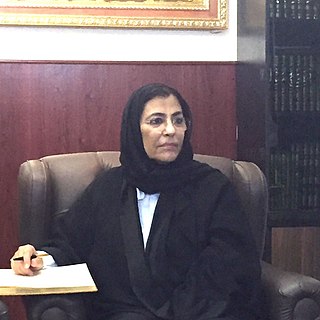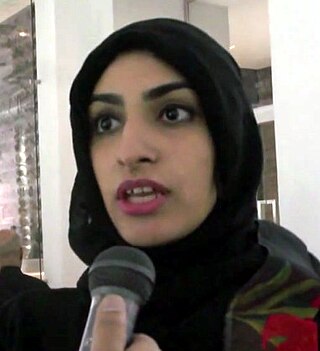Related Research Articles
Hend Al Mansour is a Saudi-American visual artist and physician. Her printed silkscreens, installation art and portraits of Muslim women explore the religious and social belief systems of Arab communities. She earned degrees in cardiology and internal medicine, practicing medicine for 20 years. She immigrated to the United States in 1997 after receiving a fellowship at the Mayo Clinic in Minnesota. She then pursued an art career, attending the Women's Art Institute at St. Catherine University and earning her MFA from Minneapolis College of Art and Design where she was mentored by Aribert Munzner.

Wahbi al-Hariri-Rifai was a Syrian American artist. He was also an accomplished architect, archaeologist, and author. His artwork has garnered international recognition and praise both in his lifetime and posthumously.
Saudi Arabian art is contextual to the country being the birthplace of Islam; it includes both the arts of Bedouin nomads and those of the sedentary peoples of regions such as the Hejaz, Tihamah, Asir and Najd.

Ahmed Mater is a Saudi artist and physician. His mediums are photography, calligraphy, painting, installation, performance and video. His work, which explores history, the narratives and aesthetics of Islamic culture, and addresses consumerism and transformation taking place in the region and its effects on geopolitics, has attracted an international audience. In 2003, he cofounded "Edge of Arabia", an independent arts initiative dedicated to promoting the appreciation of contemporary Arab art and culture, with a focus on Saudi Arabia.
Dana Claxton is a Hunkpapa Lakota filmmaker, photographer, and performance artist. Her work looks at stereotypes, historical context, and gender studies of Indigenous peoples of the Americas, specifically those of the First Nations. In 2007, she was awarded an Eiteljorg Fellowship for Native American Fine Art.
Khairat Al-Saleh, born in Jerusalem and educated in Syria and Egypt, is a noted painter in the Hurufiyya movement and a ceramicist, glassmaker and printmaker.

Huguette Caland was a Lebanese painter, sculptor and fashion designer known for her erotic abstract paintings and body landscapes. Based out of Los Angeles, her art was displayed in numerous exhibitions and museums around the world.
Wasma'a Khalid Chorbachi is an American-Iraqi artist.

Fahda bint Saud Al Saud is a Saudi royal and artist.
Abdulnasser Gharem is a Saudi Arabian artist and also a lieutenant colonel in the Saudi Arabian army. In April 2011, his installation Message/Messenger sold for a world record price at auction in Dubai.
Zarouhie Abdalian is an American artist of Armenian descent, known for site-specific sculptures and installations.
Safeya Binzagr is a Saudi Arabian artist. She is a supporter of the art scene in Jeddah. Binzagr opened her own museum and gallery, the Darat Safeya Binzagr in 2000. She is the only artist in her country to have their own museum.
Huda Ahmad Totonji is a Saudi-born American visual artist, designer, and educator. Totonji is also a master calligrapher and is certified to teach Arabic Calligraphy. In addition to her calligraphic work, she also creates mixed media art, installations and performance art. Totonji is the president of Huda Art, LLC, which creates custom art for clients. Totonji is also the first person from Saudi Arabia to lecture at Harvard University.

Sarah Mohanna Al Abdali is a Saudi Arabian artist, who is considered one of the country's first street artists. Her work combines Saudi and Arab cultural motifs and aims to provoke debate.
Jill Mulleady is an artist. She was born in Montevideo, Uruguay and grew up in Buenos Aires, Argentina. She moved to London to study at Chelsea School of Art, in 2007–09, where she received a Master of Fine Arts. She lives and work in Los Angeles, California.
Shalimar Sharbatly is a Saudi Arabian abstract painter. She was the first woman to be commissioned by the government to do street artwork. Her hand-painted, abstract designed Porsche 911 was featured at the Louvre.

Manal Al Dowayan is a Saudi Arabian contemporary artist, best known for her installation piece Suspended Together from the Home Ground Exhibition at the Barjeel Art Foundation in 2011. She has shown work in a number of shows including the 2012 Soft Power show at Alan Art Center in Riyadh, Saudi Arabia, the 2013 Journey of Belonging, a solo show at Athr Gallery in Jeddah, Saudi Arabia, the 2017 100 Masterpieces of Modern and Contemporary Arab Art in Paris, France, as well as having her work exhibited in the 2014 USA Biennial in Houston, the 2015 P.3: Prospect New Orleans USA Biennial Notes For Now, and the Venice Biennale in the Future of a Promise Exhibition. Her work spans many mediums from photography to installation and focuses on a progressive examination and critique women's roles in Saudi society.
Zahrah Al Ghamdi is a Saudi Arabian visual and land artist, as well as an assistant professor at the College of Art and Design at the University of Jeddah.
Shadia Alem is a Saudi Arabian visual artist. She is known for her sculpture, installation art, and painting. She lives and works between Paris and Jeddah.
Basmah Felemban is a Saudi Arabian, self-taught graphic designer. She has an interest in symbolism and Islamic metaphysics.
References
- ↑ Nihal, Mariam (2 March 2018). "Dana Awartani turned history into mesmerizing works of art".
- ↑ "Saudi-Palestine artist's creative genius wows KMB".
- ↑ "CV – Dana Awartani" . Retrieved 2024-05-20.
- ↑ "How the Saudi art scene is determined to keep up with the changes of its country". 14 February 2018.
- 1 2 "Collections Online". British Museum. Retrieved 19 December 2021.
- 1 2 "Towards A Sublime Art". Harper's Bazaar Arabia. Retrieved 20 March 2018.
- ↑ "Beyond the veil: Saudi women making their presence". Financial Times. 24 February 2017.
- ↑ "Dana Awartani and the universal language of sacred geometry". CNN . 15 December 2016.
- ↑ Post, The Jakarta. "Jakarta Biennale: A new understanding of contemporary Indonesian art".
- ↑ "How Saudi artists are capturing the spirit of a kingdom in the process of radical reform". Independent.co.uk . 10 March 2018.
- ↑ "Dana Awartani". Edge of Arabia. Retrieved 20 March 2018.
- ↑ "Exhibition 1". The Brooklyn Rail. June 2017.
- ↑ RAWAN, RADWAN (25 March 2014). "Dana Awartani: Decoding Islamic art". Arab news. Retrieved 20 March 2018.
- ↑ "Dana Awartani: Transforming Faith Into Sacred Islamic Art". nahlaink.com. Archived from the original on 27 September 2018. Retrieved 20 March 2018.
- ↑ "Rhizoma: 55th Venice Biennale". Dalloul Art Foundation. Retrieved 20 December 2021.
- ↑ "Hirshhorn Announces 30 New Works Entering the Museum's Collection". Hirshhorn Museum and Sculpture Garden | Smithsonian. Retrieved 20 December 2021.